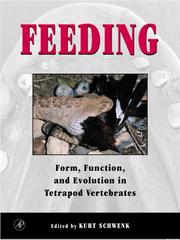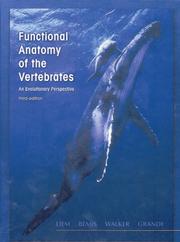| Listing 1 - 4 of 4 |
Sort by
|

ISBN: 0126325901 9786611057077 128105707X 0080531636 9780126325904 9780080531632 Year: 2000 Publisher: San Diego Academic Press
Abstract | Keywords | Export | Availability | Bookmark
 Loading...
Loading...Choose an application
- Reference Manager
- EndNote
- RefWorks (Direct export to RefWorks)
As the first four-legged vertebrates, called tetrapods, crept up along the shores of ancient primordial seas, feeding was among the most paramount of their concerns. Looking back into the mists of evolutionary time, fish-like ancestors can be seen transformed by natural selection and other evolutionary pressures into animals with feeding habitats as varied as an anteater and a whale. From frog to pheasant and salamander to snake, every lineage of tetrapods has evolved unique feeding anatomy and behavior. Similarities in widely divergent tetrapods vividly illustrate their shared common ancestry. At the same time, numerous differences between and among tetrapods document the power and majesty that comprises organismal evolutionary history. Feeding is a detailed survey of the varied ways that land vertebrates acquire food. The functional anatomy and the control of complex and dynamic structural components are recurrent themes of this volume. Luminaries in the discipline of feeding biology have joined forces to create a book certain to stimulate future studies of animal anatomy and behavior.
Vertebrates --- Digestive organs. --- Food. --- Vertebrata --- Chordata --- AMPHIBIA --- REPTILES --- MAMMALS --- VERTEBRATES --- FEEDING --- MORPHOLOGY --- EVOLUTION --- FUNCTIONAL RESPONSES

ISBN: 9780126325904 0126325901 9780080531632 0080531636 9786611057077 Year: 2000 Publisher: San Diego Academic Press
Abstract | Keywords | Export | Availability | Bookmark
 Loading...
Loading...Choose an application
- Reference Manager
- EndNote
- RefWorks (Direct export to RefWorks)
As the first four-legged vertebrates, called tetrapods, crept up along the shores of ancient primordial seas, feeding was among the most paramount of their concerns. Looking back into the mists of evolutionary time, fish-like ancestors can be seen transformed by natural selection and other evolutionary pressures into animals with feeding habitats as varied as an anteater and a whale. From frog to pheasant and salamander to snake, every lineage of tetrapods has evolved unique feeding anatomy and behavior. Similarities in widely divergent tetrapods vividly illustrate their shared common ancestry. At the same time, numerous differences between and among tetrapods document the power and majesty that comprises organismal evolutionary history. Feeding is a detailed survey of the varied ways that land vertebrates acquire food. The functional anatomy and the control of complex and dynamic structural components are recurrent themes of this volume. Luminaries in the discipline of feeding biology have joined forces to create a book certain to stimulate future studies of animal anatomy and behavior.
Vertebrates --- Food. --- Digestive organs. --- AMPHIBIA --- REPTILES --- MAMMALS --- VERTEBRATES --- FEEDING --- MORPHOLOGY --- EVOLUTION --- FUNCTIONAL RESPONSES

ISBN: 0030223695 9780030223693 Year: 2001 Publisher: Fort Worth : Harcourt College Publishers,
Abstract | Keywords | Export | Availability | Bookmark
 Loading...
Loading...Choose an application
- Reference Manager
- EndNote
- RefWorks (Direct export to RefWorks)
Vertebrates --- Anatomy, Comparative. --- Vertébrés --- Anatomie comparée --- Anatomy. --- Evolution. --- Anatomie --- Evolution --- Comparative anatomy --- Comparative morphology --- Zootomy --- Zoology --- Vertébrés --- Anatomie comparée --- Anatomy, Comparative --- Anatomy --- Zoomorphology. Zooanatomy --- VERTEBRATES --- FUNCTIONAL RESPONSES --- ANATOMY --- EVOLUTION
Book
ISBN: 0691209960 Year: 1978 Publisher: Princeton, N.J. : Baltimore, Md. : Princeton University Press, Project MUSE,
Abstract | Keywords | Export | Availability | Bookmark
 Loading...
Loading...Choose an application
- Reference Manager
- EndNote
- RefWorks (Direct export to RefWorks)
In this study of arthropod predador-prey systems Michael Hassell shows how many of the components of predation may be simply modeled in order to reveal their effects on the overall dynamics of the interacting populations. Arthropods, particularly insects, make ideal subjects for such a study because their generation times are characteristically short and many have relatively discrete generations, inviting the use of difference equation models to describe population changes. Using analytical models framed in difference equations, Dr. Hassell is able to show how the detailed biological processes of insect predator-prey (including host-parasitoid) interactions may be understood. Emphasizing the development and subsequent stability analysis of general models, the author considers in detail several crucial components of predator-prey models: the prey's rate of increase as a function of density, non-random search, mutual interference, and the predator's rate of increase as a function of predator survival and fecundity. Drawing on the correspondence between the models and field and laboratory data, Dr. Hassell then discusses the practical implications for biological pest control and suggests how such models may help to formulate a theoretical basis for biological control practices.
Predation (Biologie) --- Insectes --- Insectes predateurs. --- Parasitoïdes. --- arthropode --- Predation (Biology) --- Arthropoda. --- Modeles mathematiques7 --- Populations --- Modeles mathematiques. --- dynamique des populations --- modele mathematique --- predation. --- Mathematical models. --- Nicholson-Bailey model. --- age structure. --- biological control. --- density dependence. --- disc equation. --- equilibria. --- extinction. --- functional responses. --- generalists. --- hyperparasitoids. --- interference. --- life tables. --- limit cycles. --- multiparasitism. --- negative binomial distribution. --- non-random search. --- optimal foraging. --- oscillations. --- parasitoids: contrasted with predators. --- predator: aggregation. --- preference. --- random parasitoid equation. --- searching behavior. --- spatial heterogeneity. --- survival. --- switching. --- time delays. --- zero growth isoclines.
| Listing 1 - 4 of 4 |
Sort by
|

 Search
Search Feedback
Feedback About UniCat
About UniCat  Help
Help News
News